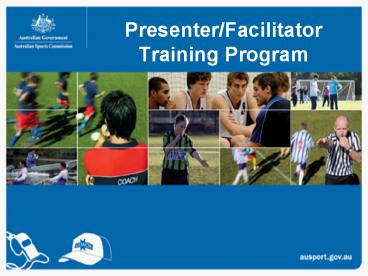Presenter/Facilitator Training Program - PowerPoint PPT Presentation
1 / 24
Title:
Presenter/Facilitator Training Program
Description:
Presenter/Facilitator Training Program. Why train presenters? To develop better ... How to plan a training session. Dealing with conflict. Ethics & responsibilities ... – PowerPoint PPT presentation
Number of Views:100
Avg rating:3.0/5.0
Title: Presenter/Facilitator Training Program
1
Presenter/Facilitator Training Program
2
Why train presenters?
- To develop better coaches and officials...
- We need great presenters and facilitators to
educate them!
3
How to structure learning
Structure learning that is RAVE
R responsible Did the session allow learners to take responsibility for their learning?
A active How active and involved was the group?
V variety Did the session involve a variety of learning methods?
E engaging Did the session capture and hold attention?
4
Skills for presenters
Presenters/facilitators should demonstrate MOAR
Qs
M message Did you get your message across and achieve the session outcomes?
O organisation Planning, organising and managing the group (people, time, resources).
A approach Adapt to deal with the difficult unexpected. Be positive, confident and in control
R review Reflect on how the session went and review what to change for next time
Q questions Did you use questions? Can you use Moar questions!
5
One-minute presentations
- Group 1
- Insert names
- Group 2
- Insert names
- Group 4
- Insert names
- Group 3
- Insert names
6
How people learn
- Where and how do coaches and officials learn
best? - Practical take theory out of the classroom
- Scenario and problem based learning
- Mentoring
7
Practical session
- You will participate in a practical session -
typical in coaching or officiating education - Then analyse the session as a presenter (how it
was delivered, not the content of what was
delivered)
8
Learning methods
- Facilitated discussion
- Practical
- Case study or scenario
- Role play
- Brainstorm
- Video/DVD
- Questioning discussion
- Web based / multi-media
- Mentoring
- Lecture/presentation
9
Difficult people
- Think of consequences.
- Action needs to be taken.
- Always remain calm.
- Person may stop if prompted.
- Be patient
10
Learning styles
Visual They like Graphs, charts, mind maps/flow charts and images. Auditory They like Discussion groups, questions, audio recordings, key points and cue words.
Read/write They like Lists, headings, written cue words/phrases. Kinaesthetic They like Demonstrations, doing the activity, learning by experiencing, video feedback, visualisation.
11
Individual needs and diversity
- Cultural differences
- Generational differences
- Hearing / vision impairments
12
Example slide Hydration
- Fluid intake before, during after activity
- Fluid intake should sweat loss
- Children have ? risk of dehydration
13
Powerpoint
- Does it add to your presentation?
- 6 words, 6 lines
- Be consistent
- Background colour
- Font colour
14
Whats wrong with this slide?
15
Planning activity
- Topics
- How to plan a training session
- Dealing with conflict
- Ethics responsibilities
- Working with kids
- Safety risk mgmt
- Plan the following
- Who is the audience?
- 3 key points
- Delivery method(s)
- Learning aids (equipment etc)
- Time allocation
16
Learning aids
- Data projector / PowerPoint
- Whiteboard Flip chart
- DVD / Video
- Worksheets / handouts
- Specialist presenters
- Instruction cards for role plays, scenarios or
activities
17
The future
- Interactive white boards
- E-learning
- Satellite
- Podcasts
18
Getting better
- Ask the audience
- Evaluation form
- Peer review
- Video yourself
- Self-reflection
- Do more presentations
19
Five-minute presentations
- Group 1
- Insert names
- Group 2
- Insert names
- Group 3
- Insert names
- Group 4
- Insert names
20
Roles and responsibilities
- NCAS and NOAS requirements
- Ambassador for the sport
- Resources and support from your sport
21
Running a workshop
- Course coordinators role.
- Logistics, admin, personnel, venue, coordination,
assessment processes - Sorting out problems
22
Risk Management
- Participant safety
- Content up to date
- Participants physically able
- Safe environment
- Presenter liability
- Insurance
- Professional indemnity
- Public liability
23
Summary
- Structure learning that is RAVE
- Presenters need to demonstrate MOAR Qs
- Use a range of learning methods aids
- Preparation and review
- Consider your audience be able to adapt
- What does your sport require of you?
- Better presenters/facilitators
better coaches and officials.
24
Thank you































